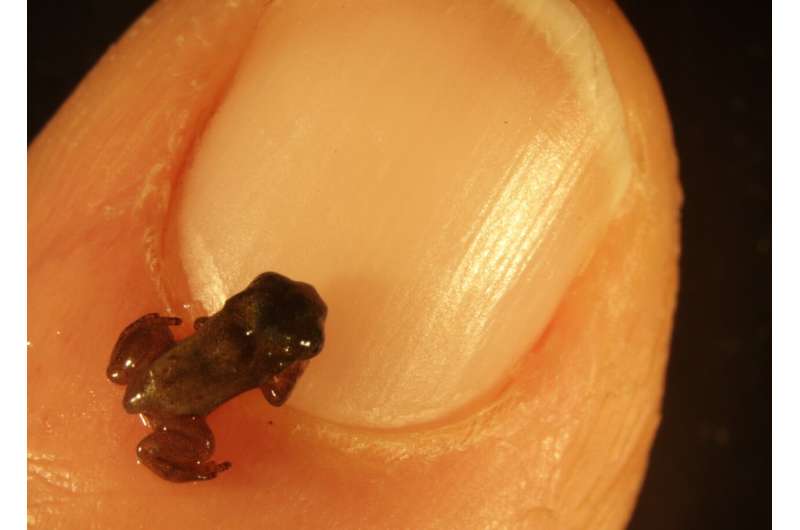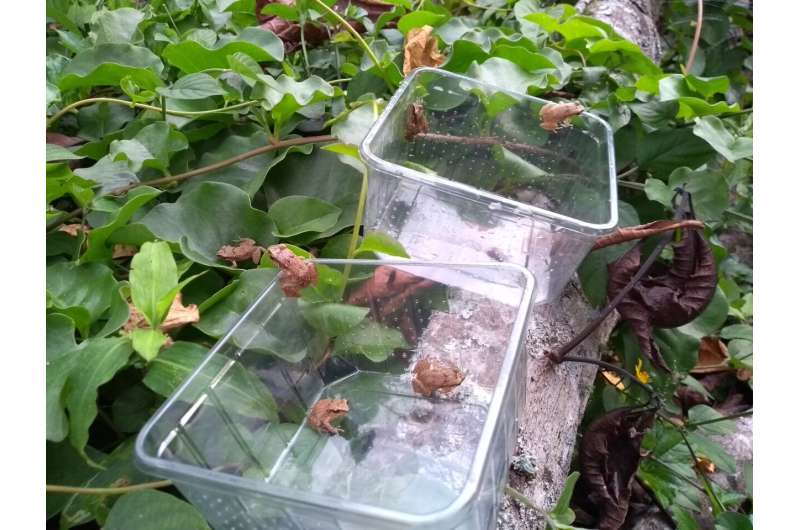This article has been reviewed according to Science X's editorial process and policies. Editors have highlighted the following attributes while ensuring the content's credibility:
fact-checked
trusted source
proofread
Frog with baggage: Invasive species do not arrive alone

Senckenberg researchers have introduced a new invasion biology concept, so-called "nested invasions." Using Johnstone's whistling frog as an example, they show that this amphibian not only colonizes foreign regions, but it also carries invasive microbiomes in its baggage. The scientists thereby provide the first comprehensive dataset for an invasive community and warn of the still unknown impact on the newly colonized ecosystems.
Animals carry trillions of bacteria, viruses, archaeans, and fungi in their digestive tracts and on their skin. These internal ecosystems help them obtain nutrients, fight pathogens, and develop their immune systems.
"Such 'microbiomes' are also found in amphibians; their skin, which is moist due to their dermal respiration, is particularly predestined for this," explains PD Dr. Raffael Ernst from the Senckenberg Natural History Collections in Dresden, and he continues, "We are interested in how these microbiomes of alien species affect native ecosystems and what role they play in the successful colonization by the immigrants."
To investigate this question, Ernst, along with first author and doctoral student Franziska Leonhardt and researchers from Munich and Stuttgart, took a close look at Johnstone's whistling frog (Eleutherodactylus johnstonei). The frog, which measures only about 17 to 35 millimeters and is originally native to the Lesser Antilles, is a highly successful invasive animal that has spread throughout the Caribbean and much of mainland Central and South America and can now also be found in botanical gardens across Europe.
"We genetically analyzed the skin and intestinal microbiomes of Eleutherodactylus johnstonei from native populations in St. Lucia and immigrant populations in Guadeloupe, Colombia, and from European greenhouses. Our results show that amphibian-associated and microbial environmental communities can be considered 'metacommunities' that interact with each other. These interactions with the environment play a greater role in the skin microbiome than in that of the gut," Leonhardt explains.

High levels of bacteria can spread between frogs and the environment, according to the study. The researchers suggest that greater attention should be paid to the spread of microbiota by alien species in order to prevent the propagation of vector-borne pathogens as well as non-pathogenic microbes.
"Community ecology concepts are at the heart of a holistic understanding of the dynamics and mechanisms of biological invasions. This is especially true when assessing the complex and diverse microbiota associated with each invasive species. To date, traditional studies have largely failed to account for these nested immigrations, and thus have ignored a potentially important aspect of invasion processes. However, we can summarize by saying that alien species do not arrive alone! Our approach can complement and broaden the traditional perspective on biological invasions—not least to provide improved conservation measures in the future," concludes Ernst.
The paper is published in the journal Microbial Ecology.
More information: Franziska Leonhardt et al, From Alien Species to Alien Communities: Host- and Habitat-Associated Microbiomes in an Alien Amphibian, Microbial Ecology (2023). DOI: 10.1007/s00248-023-02227-5




















